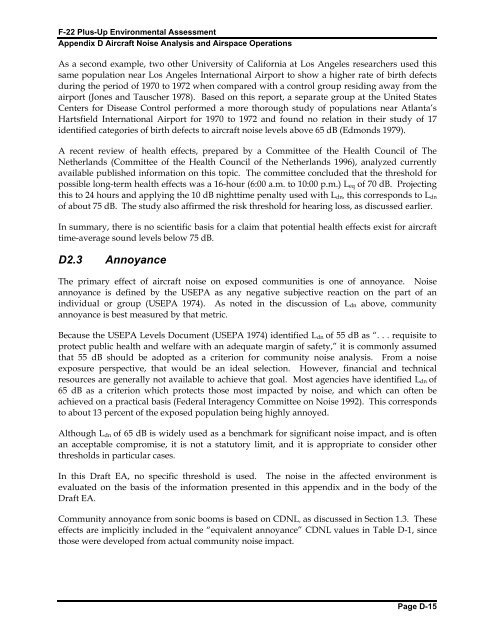F-22 Plus-Up Environmental Assessment - Joint Base Elmendorf ...
F-22 Plus-Up Environmental Assessment - Joint Base Elmendorf ...
F-22 Plus-Up Environmental Assessment - Joint Base Elmendorf ...
You also want an ePaper? Increase the reach of your titles
YUMPU automatically turns print PDFs into web optimized ePapers that Google loves.
F-<strong>22</strong> <strong>Plus</strong>-<strong>Up</strong> <strong>Environmental</strong> <strong>Assessment</strong><br />
Appendix D Aircraft Noise Analysis and Airspace Operations<br />
As a second example, two other University of California at Los Angeles researchers used this<br />
same population near Los Angeles International Airport to show a higher rate of birth defects<br />
during the period of 1970 to 1972 when compared with a control group residing away from the<br />
airport (Jones and Tauscher 1978). <strong>Base</strong>d on this report, a separate group at the United States<br />
Centers for Disease Control performed a more thorough study of populations near Atlanta’s<br />
Hartsfield International Airport for 1970 to 1972 and found no relation in their study of 17<br />
identified categories of birth defects to aircraft noise levels above 65 dB (Edmonds 1979).<br />
A recent review of health effects, prepared by a Committee of the Health Council of The<br />
Netherlands (Committee of the Health Council of the Netherlands 1996), analyzed currently<br />
available published information on this topic. The committee concluded that the threshold for<br />
possible long-term health effects was a 16-hour (6:00 a.m. to 10:00 p.m.) L eq of 70 dB. Projecting<br />
this to 24 hours and applying the 10 dB nighttime penalty used with L dn , this corresponds to L dn<br />
of about 75 dB. The study also affirmed the risk threshold for hearing loss, as discussed earlier.<br />
In summary, there is no scientific basis for a claim that potential health effects exist for aircraft<br />
time-average sound levels below 75 dB.<br />
D2.3 Annoyance<br />
The primary effect of aircraft noise on exposed communities is one of annoyance. Noise<br />
annoyance is defined by the USEPA as any negative subjective reaction on the part of an<br />
individual or group (USEPA 1974). As noted in the discussion of L dn above, community<br />
annoyance is best measured by that metric.<br />
Because the USEPA Levels Document (USEPA 1974) identified L dn of 55 dB as “. . . requisite to<br />
protect public health and welfare with an adequate margin of safety,” it is commonly assumed<br />
that 55 dB should be adopted as a criterion for community noise analysis. From a noise<br />
exposure perspective, that would be an ideal selection. However, financial and technical<br />
resources are generally not available to achieve that goal. Most agencies have identified L dn of<br />
65 dB as a criterion which protects those most impacted by noise, and which can often be<br />
achieved on a practical basis (Federal Interagency Committee on Noise 1992). This corresponds<br />
to about 13 percent of the exposed population being highly annoyed.<br />
Although L dn of 65 dB is widely used as a benchmark for significant noise impact, and is often<br />
an acceptable compromise, it is not a statutory limit, and it is appropriate to consider other<br />
thresholds in particular cases.<br />
In this Draft EA, no specific threshold is used. The noise in the affected environment is<br />
evaluated on the basis of the information presented in this appendix and in the body of the<br />
Draft EA.<br />
Community annoyance from sonic booms is based on CDNL, as discussed in Section 1.3. These<br />
effects are implicitly included in the “equivalent annoyance” CDNL values in Table D-1, since<br />
those were developed from actual community noise impact.<br />
Page D-15
















